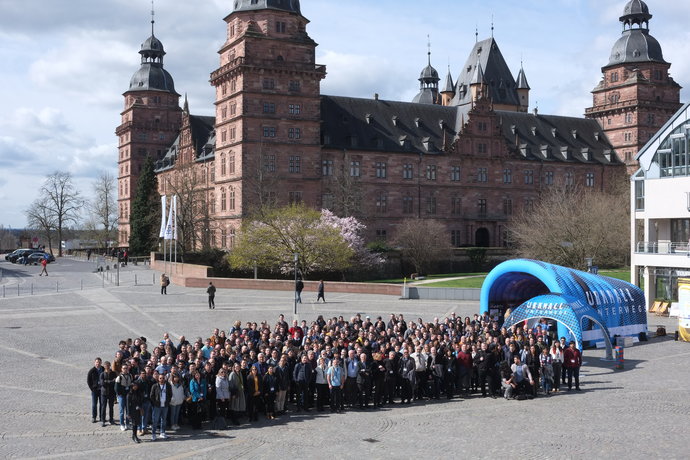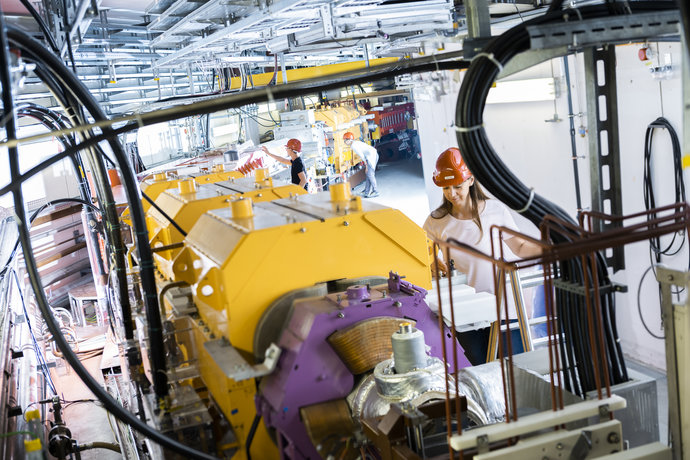
On site at GSI/FAIR, 24 interested high-school students were given the opportunity to learn more about tumor therapy with ion beams during a Masterclass in March. The event was hosted by scientists of the Biophysics research department at GSI/FAIR. All Particle Therapy Masterclasses (PTMCs) are coordinated by GSI/FAIR in the framework of the International Masterclasses of the IPPOG (International Particle Physics Outreach Group), of which GSI is an associate member.

Increasing the safety of astronauts in space and advancing modern research for the benefit of mankind: These goals are the focus of the successful cooperation between the European Space Agency ESA and GSI/FAIR in several research projects. GSI/FAIR is the European facility selected by ESA to study cosmic radiation and its effects on humans, electronics and materials. This includes the research program for "Investigations into Biological and Physical Effects of Radiation (IBPER)", which is…

High-ranking visit on the FAIR/GSI campus in Darmstadt: The Indian Ambassador, H.E. Harish Parvathaneni, was recently a guest at FAIR/GSI. Together with the India Consul General Dr. Amit S Telang from Frankfurt and Science Attaché Dr. Madhusudan Nandineni from Berlin, he informed himself about the progress and perspectives of research at GSI and FAIR and took the opportunity to meet Indian students, researchers and scientists on site...

On two days in March, the European Cryogenics Days (ECD) took place at the GSI/FAIR campus in Darmstadt. The international conference focuses on all topics related to cryogenics, from giant cryogenics applications such as the superconducting FAIR accelerator to hydrogen mobility and lowest temperatures on the tiny scales of cells. Co-hosted by the Cryogenics Society of Europe, the ECDs have been held regularly at various research institutions in Europe since 2015.

Radiation therapy, manufacturing radiopharmaceuticals, developing and certifying drugs and designing energy-efficient semiconductors and new high-performance materials – these are just some of the different areas that are of great economic relevance. They are also areas in which accelerator-based technologies offer enormous advantages to research and development, in manufacturing and for quality control. However, at present the potential of such technologies is not being fully tapped outside the…

More than 300 researchers from around the world met in Aschaffenburg, Germany, March 27 to 31, 2023, for the "11th International Conference on Hard and Electromagnetic Probes of High-Energy Nuclear Collisions."

The EU-funded project HEARTS aims at providing access to high-energy heavy ion radiation testing facilities for both space exploitation and exploration. Two new radiation-testing facilities open to space applications, such is the promise of the HEARTS project. Started last January, this project will enable testing high-end microelectronics technology for novel space applications, as well as for shielding and radiobiology experiments that will foster human space exploration. GSI, as the most…

Can nuclear physics improve the prediction of earthquakes? That is the goal of the European research project artEmis, in which the GSI Helmholtzzentrum für Schwerionenforschung is participating together with twelve other institutes. Within the framework of artEmis, which is supported by an EU grant (Euratom) of two million euros until 2027, the foundation for a reliable early warning system for earthquakes is to be laid. A network of sensors measuring radon levels and other parameters in…

Professor Gerhard Kraft, biophysicist and pioneer of modern heavy ion therapy, passed away in Heidelberg on Saturday, March 18, 2023 at the age of 81. GSI and FAIR received the news with deep sadness and mourn the loss of one of their most renowned scientists. The initiator and decisive pioneer of tumor therapy with ion beams established the biophysical research department at GSI in the early 1980s, which he headed from 1981 to 2008. For his exceptional merits, especially in cancer research and…












